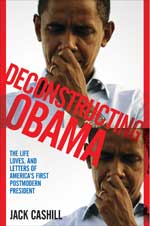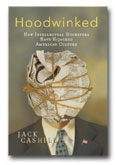A Closer Look at Obama’s Pakistan Trip
Get your copy of Deconstructing Obama

___
Jack Cashill's book:
Hoodwinked: How Intellectual Hucksters have Hijacked American Culture

Click here for signed first edition
©Jack Cashill
WND.com - June 2, 2011
At a San Francisco fundraiser in early April 2008, Senator Barack Obama made a strategic jab at the two people who stood between him and the White House.
“Foreign policy is the area where I am probably most confident that I know more and understand the world better than Senator Clinton or Senator McCain," said the ambitious candidate.
Obama took particular aim at Hillary Clinton. He countered her boast of having met leaders from 80 foreign countries with his on-the-ground experience in several key outposts.
“I traveled to Pakistan when I was in college,” said Obama in the way of illustration. “I knew what Sunni and Shia was [sic] before I joined the Senate Foreign Relations Committee."
This declaration took ABC reporter Jake Tapper by surprise. He thought it odd that he had not heard of this trip, especially “given all the talk of Pakistan during this campaign.”
Indeed, Obama had introduced Pakistan into the discussion as early as August 1, 2007. As Tapper observed at the time, Obama used Pakistan as a way of challenging Hillary’s perceived strength on foreign affairs.
Yet despite the strategic edge his Pakistan experience might have given him, Obama did not mention his 1981 Pakistan visit in that August 2007 speech or for the next eight months.
Had Tapper inquired further, he would have learned that Obama did not mention the Pakistan visit in either of his books, the 1995 “Dreams from My Father” or the 2006 “Audacity of Hope.”
Given that Obama used both of those books, especially “Audacity,” to emphasize his superior knowledge of the larger world, the omission of his Pakistan experience perplexes.
When Tapper asked the Obama campaign staff about the trip, they described it as a casual stopover to visit friends on the tail end of a trip to visit his mother and sister in Indonesia.
In retrospect, this makes one wonder whether the Indonesian leg was real or contrived. Obama’s most serious biographer, David Remnick, sheds little light on it.
In “The Bridge,” Remnick tells how Obama first visits his friends Hamid and Chandoo in Pakistan during Ramadan “and then to Indonesia to see his mother and Maya,” a three week trip in all. In 1981, Ramadan began on July 3 and ran for a lunar month.
In “A Singular Woman,” Janny Scott’s biography of Obama’s mother, Ann Dunham, Scott has Obama circling the world in the opposite direction and in a different time frame.
Scott writes of summer 1981, “Barry spent July in Jakarta, then went to Pakistan to visit a friend from Occidental [College] on his way back to the United States.”
As confirmation, Scott includes a letter purportedly written in May 1981 to Dunham’s employers at the Ford Foundation: “I would like to use my educational travel for dependent children to have my son, Barry, come out to visit us.”
I say “purportedly” because Scott, like Remnick, is capable of deception to protect the Obama narrative. For instance, both lead their readers to believe that Obama lived with his mother and father in Hawaii for the first six months of his life.
The evidence is undeniable, however, that the family never lived together. Dunham was in Seattle with her son within weeks of the birth. The finessing of the timeline, most egregiously by Scott, had to be purposeful.
Scott provides no detail at all of Obama’s 1981 Indonesian visit. She does, however, provide eyewitness testimony of a 1983 visit to Indonesia by Obama.
This seemingly gratuitous insertion of the 1981 letter to the Ford Foundation serves two purposes: it confirms the Indonesian leg of the trip and it explains the financing behind it.
It would not overly matter that Scott, a New York Times reporter, and Remnick, the editor of the New Yorker, would tell conflicting stories about this Asian junket were it routine.
But it was not. At the time they were writing, each knew the trip was controversial. Although Scott gives no hint of the controversy, Remnick does. He quotes an old girlfriend of Chandoo, who accuses Fox News of twisting the Pakistan visit “into something awful.”
What made the trip controversial was not what Obama did once he got to Pakistan, but how he got there. In 1981, Pakistan was not an easy or likely destination for an American tourist.
This prompted some noise in the blogosphere that Obama could not have traveled to Pakistan as an American citizen. Quick to Obama’s defense as always, FactCheck,org made the valid case that American citizens could travel to Pakistan in 1981 and thus dismissed the travel issue as “more ‘Birther’ nonsense.”
The fact that Obama could have traveled to Pakistan on an American passport, however, does not mean that he did. Not surprisingly, FactCheck fails to mention the variable that prompted the controversy in the first place, namely Obama’s curious silence about the trip until April 2008.
Nor, of course, does FactCheck mention the event that took place just weeks before Obama’s first mention of the Pakistan visit, an event that should have made every reporter in America suspicious.
In March 2008, contract employees for the State Department were caught breaching the passport files of the three still viable presidential candidates, Obama, McCain, and Clinton.
While the media allowed Obama to pontificate about the sanctity of confidential records, they spared the public the knowledge that Obama's file was uniquely visited on three occasions.
Worse, the media scarcely mentioned another crucial detail. CNN reported the following in a throw-away piece on March 22 (a date I correctly guessed as a Saturday):
“The CEO of a company whose employee is accused of improperly looking at the passport files of presidential candidates is a consultant to the Barack Obama campaign, a source said Saturday.”
That CEO, John O. Brennan, spent nearly 30 years in the CIA. Incredibly, he is now Deputy National Security Advisor for Homeland Security and Counterterrorism.
One of the many media scandals of the 2008 campaign was the hasty burial of this story. Remnick does not mention the incident in “The Bridge.” Nor do Mark Halperin and John Helleman mention it in “Game Change,” their definitive book on the campaign.
How hard would it have been for Brennan’s man to add a 1981 Pakistan-Indonesia stamp to Obama’s American passport? If not this, what the hell he was doing in the files and why is no one asking?

Note: To understand the media flap around Jack's book, Deconstructing Obama, please check out this short video below:
Source: http://youtu.be/ofxJtwQV4IY
Editor's note: For a more complete account of this phenomenon, read Jack Cashill's amazing book, "Hoodwinked: How Intellectual Hucksters Have Hijacked American Culture.
